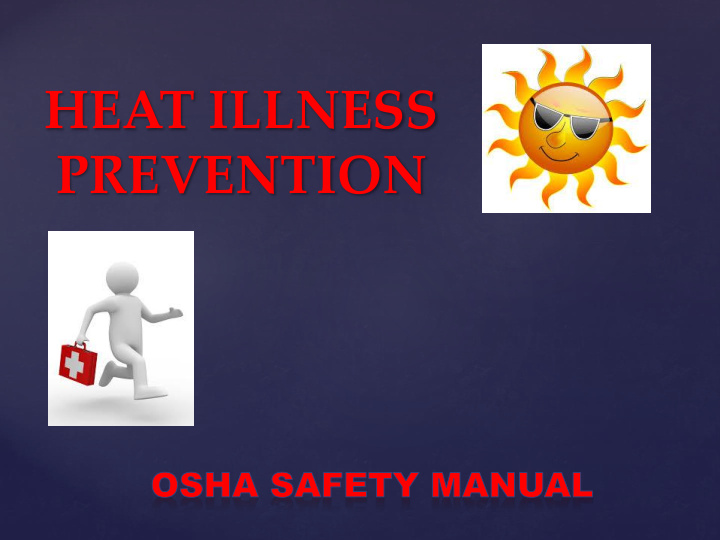



HEAT ILLNESS PREVENTION
Applies to “outdoor places of employment.” Agriculture Construction Landscaping Oil and gas extraction Transportation or delivery of materials except where vehicle is air-conditioned and employees are not required to load/unload
Employers shall establish, implement, and maintain an effective Heat Illness Prevention Plan; the HIPP must be: • in writing, and • available at the worksite The HIPP must be in English and in the language understood by the majority of employees
PROVISION OF WATER • At least one quart per employee, per hour • Fresh and pure • Suitably cool (cooler than the outside temperature, but not so cool as to cause discomfort) • As close as practicable to the areas where employees are working
ACCESS TO SHADE • Shade must be present when temperature exceeds 80 degrees • Enough shade to accommodate all employees on rest, recovery, and meal breaks • As close as practicable to the areas where employees are working • Alternative measures may be taken which are at least as effective as shade (such as misting machines) – but not in the agricultural industry
ACCESS TO SHADE • Employees shall be encouraged to take preventative cool-down rest breaks in shade when they feel the need to do so, and encouraged to remain until symptoms have abated (no less than 5 minutes) • Employer shall closely monitor employees taking preventative rest breaks • If an employee exhibits signs or reports symptoms of heat illness, the employer shall implement emergency response procedures
HIGH-HEAT PROCEDURES ( when temperature reaches 95 degrees ) • Effective communication with supervisors by voice, observation, or mobile phone • Observation of employees by one or more of the following methods: • Direct supervision of 20 or fewer employees • Mandatory buddy system • Regular communication with sole employee • Other effective means
HIGH-HEAT PROCEDURES • Designate authorized employees at each site to contact emergency medical services • Remind employees to drink plenty of water throughout the shift • Pre-shift meetings to: • Review high heat procedures • Remind employees to drink plenty of water • Take cool-down rest breaks whenever necessary • Additional requirements for employees in Agriculture (10 minute break every two hours, etc.)
EMERGENCY RESPONSE PROCEDURES • Supervisor’s response to signs and symptoms of heat illness, including first aid measures and summoning emergency medical services • Immediate action by supervisor based on level of heat illness • Contacting emergency medical services and providing clear and precise directions
ACCLIMITIZATION • Close supervision of employees during “heat wave” – “Heat Wave” means: • Predicted temperature above 80°F, and • 10°F hotter than average high temperature of preceding 5 days • In “high heat areas,” close observation of employees during first 14 days of employment
TRAINING (regarding EVERYTHING) • Training must be provided to address “the employer’s procedures for complying with this standard. • Including right of employees to exercise their rights without retaliation
MANDATORY WRITTEN PROCEDURES • Every HIPP shall include the following written procedures: • Provision of water • Access to shade • Emergency Response Procedures • Acclimatization • High-Heat Procedure
Recommend
More recommend